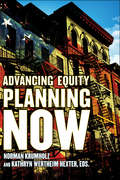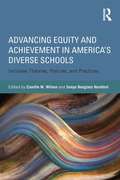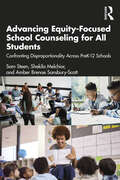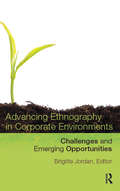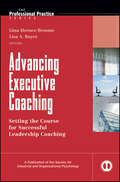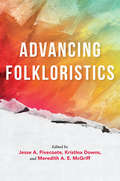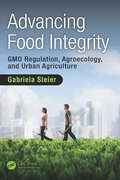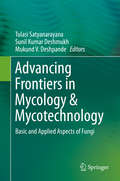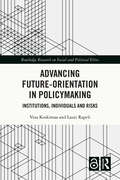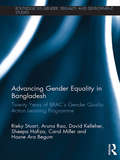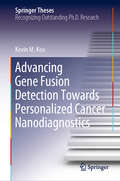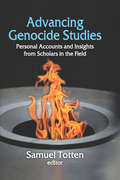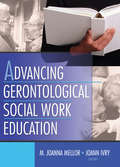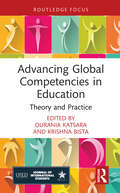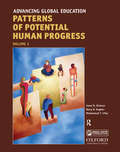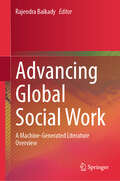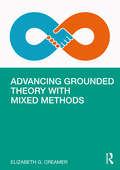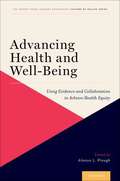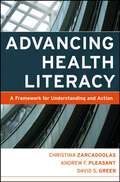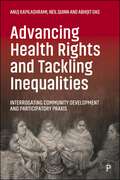- Table View
- List View
Advancing Equity Planning Now
by Edited by Norman Krumholz and Kathryn Wertheim HexterWhat can planners do to restore equity to their craft? Drawing upon the perspectives of a diverse group of planning experts, Advancing Equity Planning Now places the concepts of fairness and equal access squarely in the center of planning research and practice. Editors Norman Krumholz and Kathryn Wertheim Hexter provide essential resources for city leaders and planners, as well as for students and others, interested in shaping the built environment for a more just world.Advancing Equity Planning Now remind us that equity has always been an integral consideration in the planning profession. The historic roots of that ethical commitment go back more than a century. Yet a trend of growing inequality in America, as well as other recent socio-economic changes that divide the wealthiest from the middle and working classes, challenge the notion that a rising economic tide lifts all boats. When planning becomes mere place-making for elites, urban and regional planners need to return to the fundamentals of their profession. Although they have not always done so, planners are well-positioned to advocate for greater equity in public policies that address the multiple objectives of urban planning including housing, transportation, economic development, and the removal of noxious land uses in neighborhoods.Thanks to generous funding from Cleveland State University, the ebook editions of this book are available as Open Access volumes from Cornell Open (cornellopen.org) and other repositories.
Advancing Equity and Achievement in America's Diverse Schools: Inclusive Theories, Policies, and Practices
by Sonya Douglass Horsford Camille M. WilsonAdvancing Equity and Achievement in America’s Diverse Schools illustrates how educators, students, families and community partners can work in strategic ways to build on social, cultural, and ethnic diversity to advance educational equity and achievement. By drawing on the latest data on demographic change, constructions of culture and cultural difference, and the politics of school reform in urban, rural, and suburban school communities, this volume looks toward solutions and strategies for meaningful educational improvement. Contributors consider both the diversity of youth and families served in public schools, and the culture of U.S. schooling, highlighting the influence of policy and reform agendas; students’ identities and agency; experiences and approaches of diverse educators; and the workings of effective school partnerships. Chapters also focus on those often overlooked in educational scholarship such as Native Americans, students experiencing poverty and/or homelessness, Muslim students, students with special needs, and students and educators who are lesbian, gay, bisexual, transgender, intersex, or queer. In all, this edited collection stresses the need for high quality education that is inclusive, culturally responsive and unifying so all students can experience academic success. This book is a meaningful resource for educators, policymakers, and community-based leaders interested in doing such transformative work.
Advancing Equity-Focused School Counseling for All Students: Confronting Disproportionality Across PreK-12 Schools
by Sam Steen Shekila Melchior Amber Brenae Sansbury-ScottUsing author narratives, this book brings attention to racial disparities that currently exist in schools within the historical context of pivotal legal cases in America while emphasizing the importance of assessing and supporting students through a culturally appropriate lens that recognizes student strengths. The authors provide current and historical frameworks through which school counselors can develop a more socially just and liberation-orientated school counseling program. These frameworks center and unveil the ways in which social rank, segregation, and racism influence development, particularly for Black and Brown children. The book underscores the value of community partnerships and the role of strategic partnerships to support a college culture, particularly for student populations with historically limited access to higher education. Readers will also learn about misconceptions of racially and ethnically minoritized children and the related impacts on misdiagnosis and overrepresentation in special education. School counselors looking to ensure equity and social justice within their classrooms, analyze their own privilege, and support students of all backgrounds will find this timely text indispensable in creating a program that fosters understanding and growth.
Advancing Ethnography in Corporate Environments: Challenges and Emerging Opportunities
by Brigitte JordanIn this innovative volume, twelve leading scholars from corporate research labs and independent consultancies tackle the most fundamental and contentious issues in corporate ethnography. Organized in pairs of chapters in which two experts consider different sides of an important topic, these provocative encounters go beyond stale rehearsals of method and theory to explore the entanglements that practitioners wrestle with on a daily basis. The discussions are situated within the broader universe of ethnographic method and theory, as well as grounded in the practical realities of using ethnography to solve problems in the business world. The book represents important advances in the field and is ideal for students and scholars as well as for corporate practitioners and decision makers.
Advancing Executive Coaching
by Gina Hernez-Broome Lisa A. BoyceFor anyone who coaches leaders, this book addresses the most critical issues impacting the future of leadership coaching as an organizational development initiative. It is organized around a Leadership Coaching Framework that employs a systems approach to frame the myriad issues. In addition to the introductory chapter that provides an overview of the book, the sixteen contributed chapters are grouped into three sections with the final chapter providing a review of the major themes in the volume with a discussion integrating the global discussions and future directions for leadership coaching.
Advancing Face and Hand Transplantation: Principles and Framework for Developing Standardized Protocols
by Board on Health Care Services Board on Health Sciences Policy National Academies of Sciences, Engineering, and Medicine Health and Medicine Division Committee on Principles and Framework to Guide the Development of Protocols and Standard Operating Procedures for Face and Hand TransplantsWhen someone experiences the loss of a limb or severe facial disfigurement, one of their options may be vascularized composite allotransplantation (VCA), which transfers a graft containing multiple tissues transferred as a functional unit. Using VCA to restore the functionality and aesthetics of a lost upper limb or disfigured face is a profound and life-altering gift; however, the process and the decision to accept (or donate) a VCA graft is complex and deeply emotional. In addition to psychosocial considerations, a VCA recipient must commit to undergoing years of rigorous rehabilitation, have a robust support system in place, and accept and understand the risks of being on immunosuppressive drugs for the rest of their life. Despite VCA advances over the last 25 years, challenges remain, and the small number of recipients of face or hand transplants makes it difficult to generalize outcomes. To address these challenges, the Department of Defense Reconstructive Transplant Research Program tasked a committee of the National Academies with developing principles and a framework for the standardization, assessment, and validation of protocols and standard operating procedures for face and hand transplantation. The resulting report offers guidance for the newly established Clinical Organization Network for Standardization of Reconstructive Transplantation (CONSORT), but it also includes specific recommendations to enable the larger VCA community to mature, advance, and thrive into the future.
Advancing Folkloristics
by Debra Lattanzi Shutika Trevor J. Blank Kay Turner Anika Wilson Andrea Kitta Solimar Otero Margaret A. Mills Lynne S. McNeill Cory W. Thorne Phyllis M. May-Machunda Jeanmarie Rouhier-Willoughby Guillermo De Los Reyes Gregory Hansen Betty J. Belanus Anthony Guest-Scott Wanda G. Addison Norma Elia CantúAn unprecedented number of folklorists are addressing issues of class, race, gender, and sexuality in academic and public spaces in the US, raising the question: How can folklorists contribute to these contemporary political affairs? Since the nature of folkloristics transcends binaries, can it help others develop critical personal narratives?Advancing Folkloristics covers topics such as queer, feminist, and postcolonial scholarship in folkloristics. Contributors investigate how to apply folkloristic approaches in nonfolklore classrooms, how to maintain a folklorist identity without a "folklorist" job title, and how to use folkloristic knowledge to interact with others outside of the discipline. The chapters, which range from theoretical reorientations to personal experiences of folklore work, all demonstrate the kinds of work folklorists are well-suited to and promote the areas in which folkloristics is poised to expand and excel. Advancing Folkloristics presents a clear picture of folklore studies today and articulates how it must adapt in the future.
Advancing Food Integrity: GMO Regulation, Agroecology, and Urban Agriculture
by Gabriela SteierKey features: Presents summaries of key points after each chapter and includes color graphs to visualize the big-picture concepts Demonstrates how urban rooftop farms (URFs) can contribute to city greening and climate change mitigation worldwide while providing fresh locally-sourced produce for growing urban populations Provides cutting-edge ideas from the the emerging field of food law and places international and comparative legal concepts into an accessible context for non-lawyers Examines major disputes surrounding food products that have been brought before the World Trade Organization (WTO) to illustrate how trade trends have pushed toward GMO proliferation Uses examples of food labeling, pollinator protection, pesticide permitting, invasive species control, and GMO regulatory policy in the US and the EU to illustrate various methods of bringing public law to the forefront in the struggle toward achieving food integrity The proliferation of Genetically Modified Organisms (GMOs) in our increasingly globalized food system is trivializing the inherent risks to a sustainable world. Responding to the realities of climate change, urbanization, and a GMO-dominated industrialized food system, Gabriela Steier's seminal work addresses the interrelationship of these cutting-edge topics within a scholarly, legal context. In Advancing Food Integrity: GMO Regulation, Agroecology, and Urban Agriculture, Steier defines food integrity as the optimal measure of environmental sustainability and climate change resilience combined with food safety, security, and sovereignty for the farm-to-fork production and distribution of any food product. The book starts with a discussion of the food system and explores whether private law has sufficiently protected food or whether public law control is needed to safeguard food integrity. It proceeds to show how the proliferation of GMOs creates food insecurity by denying people’s access to food through food system centralization. Steier discusses how current industrial agricultural policy downplays the dangers of GMO monocultures to crop diversity and biodiversity, thereby weakening food production systems. Striving to promote agroecology by providing a fresh and compelling narrative of interdisciplinary questions, Steier explores how farming can be geared toward more sustainable and environmentally friendly practices worldwide in the future. This book belongs in the libraries of all those interested in food law, environmental law, agroecology, sustainable agriculture, and urban living practices.
Advancing Frontiers in Mycology & Mycotechnology: Basic and Applied Aspects of Fungi
by Tulasi Satyanarayana Sunil Kumar Deshmukh Mukund V. DeshpandeThe book provides an introduction to the basics of fungi, discussing various types ranging from edible mushrooms to Neurospora – a model system for genetics and epigenetics. After addressing the classification and biodiversity of fungi, and fungi in different ecological niches, it describes the latest applications of fungi, their role in sustainable environments and in alleviating stress in plants, as well as their role in causing plant and animal diseases. Further chapters explore the advances in fungal interactions research and their implications for various systems, and discuss plant-pathogen interactions. The book also features a section on bioprospecting, and is an extremely interesting and informative read for anybody involved in the field of mycology, microbiology and biotechnology teaching and research.
Advancing Future-Orientation in Policymaking: Institutions, Individuals and Risks (Routledge Research on Social and Political Elites)
by Lauri Rapeli Vesa KoskimaaThis book argues that, under certain societal and institutional conditions, party-, interest group- and bureaucracy-based elites can interact positively to extend political timeframes beyond short electoral terms and foster reasoned long-term planning for democratic decision-making.Focusing on Finland within a broader analytic framework and comparative context, it unearths institutions and practices that give the elites capacity to curtail democratic short-sightedness and offer long-term solutions for contemporary threats such as economic globalization, climate change and geopolitical competition. The study also reveals factors that condition the operative capacity of futureregarding institutions.This book will be of key interest to scholars, students and practitioners of political science, public policy and administration, elites and management and futures studies.The Open Access version of this book, available at www.taylorfrancis.com, has been made available under a Creative Commons Attribution-Non- Commercial (CC-BY-NC) 4.0 license.
Advancing Gender Equality in Bangladesh: Twenty Years of BRAC’s Gender Quality Action Learning Programme (Routledge ISS Gender, Sexuality and Development Studies)
by Carol Miller Aruna Rao David Kelleher Rieky Stuart Sheepa Hafiza Hasne Ara BegumIn 1994, BRAC, the world's largest NGO, made headlines by putting women's rights centre stage in Bangladesh, one of the poorest countries in the world. The Gender Quality Action Learning (GQAL) Programme was one of the very first large-scale efforts to mainstream gender equality and aimed to weave objectives of gender equality throughout its own microfinance, education and health services. Advancing Gender Equality in Bangladesh describes the history, implementation, and outcome of this major 20-year initiative and discusses the lessons learnt throughout the fight to achieve gender equality outcomes in an effort to provide a tangible framework for future organizations interested in promoting gender equality and social inclusion. At a time when many gender equality programmes are still relatively young, this book offers a unique opportunity to track 20 years of intervention within a theoretical and cultural context and provides a platform for ongoing discussion about the roles of empowerment and gender transformation as agents for social change. This book provides an in-depth analysis of how strategies for change have operated in practice and will be of considerable interest to students, researchers and practitioners of international development, gender studies and social justice theory as well as those interested in a new practical methodology of the gender role framework.
Advancing Gene Fusion Detection Towards Personalized Cancer Nanodiagnostics (Springer Theses)
by Kevin M. KooThis book presents a unique concept of merging nanotechnology and novel urinary biomarkers for accurate early prostate cancer detection, discussing an entire progressive pipeline of innovative new strategies in biosensor development, from a simple colorimetric system to a complex system for simultaneous multiple biomarker sensing. For newcomers to the field of nucleic acid biosensing, it also describes various isothermal amplification and amplification-free strategies, which are currently the main research areas. Lastly, the book introduces and demonstrates the notion of clinical nanobiosensor validation toward clinical translation: the ultimate aim of researchers in the biosensor field. This book is a valuable reference resource learners seeking inspiration for cancer biosensor development.
Advancing Gene-Targeted Therapies for Central Nervous System Disorders: Proceedings Of A Workshop
by Engineering Medicine National Academies of SciencesOn April 23 and 24, 2019 the Forum on Neuroscience and Nervous System Disorders convened a workshop titled "Advancing Gene-Targeted Therapies for Central Nervous System Disorders" in Washington, DC. This public workshop brought together experts and key stakeholders from academia, government, industry, philanthropic foundations, and disease/patient-focused nonprofit organizations to explore approaches for advancing the development of gene-targeted therapies for central nervous system (CNS) disorders, and implications of developing these therapies. Participants explored lessons learned from both successful and unsuccessful clinical development programs; new knowledge about the genetic underpinnings of brain disorders; the current status and future potential of gene-targeted therapies for CNS disorders; challenges and potential solutions for translating preclinical findings to approved therapies; and patient and caregiver perspectives. They also discussed what will be needed to develop these therapies for common disorders such as Alzheimer's and Parkinson's disease, as well as neuropsychiatric and neurodevelopmental disorders such as schizophrenia and autism. The workshop included approaches that target both DNA and RNA, as well as gene products using viral vectors, antisense oligonucleotides, and RNA interference. This publication summarizes the presentations and discussion of the workshop.
Advancing Genocide Studies: Personal Accounts and Insights from Scholars in the Field
by Samuel TottenAdvancing Genocide Studies follows in the footsteps of the editor's earlier volume, Pioneers of Genocide Studies. Here a new generation of scholars presents personal essays that reveal their motivation to study genocide, the passion that drives them to continue its study, their primary scholarly interests and efforts, and their perspective on the field as it currently stands.The contributors come from diverse backgrounds, numerous different nations and various disciplines: Kjell Anderson (The Netherlands, criminology); Yair Auron (Israel, history and education); Taner Akcam (Turkey and United States, history and sociology); Alexander Alvarez (United States, criminology); Gerry Caplan (Canada, history); Craig Etcheson (United States, international relations); Maureen Hiebert (Canada, political science); Adam Jones (Canada, political science); Henry Theriault (United States, philosophy); Samuel Totten (United States, history and political science); and Ugor Ungor (The Netherlands, history and sociology).All the contributors are well known in the field of genocide studies, and all have made important contributions to this area. Variously, they have done important theoretical work, produced new findings vis-a-vis old cases of genocide, and are pursuing new issues and topics within the field of genocide studies. Many have worked "on the ground" and bring a sense of immediacy to various crises.
Advancing Gerontological Social Work Education
by Joanna Mellor Joann Ivrys your gerontological social work program as comprehensive-and as well attended-as it could be? Advancing Gerontological Social Work Education will help you develop courses that effectively prepare social work students and practitioners to work with the ever-increasing older population. It clearly presents the rationale for geriatric/gerontological preparation and defines the current status of geriatric/gerontological education. With fascinating case studies, detailed curricula, and a review of the skills and knowledge competencies necessary for effective geriatric social work practice, this book also describes a variety of courses and teaching programs in detail-noting the problems that other educators have encountered and offering practical suggestions to help in replicating the programs in other institutions. This book is especially useful because it not only examines the issues surrounding-and need for-increased gerontological education for social workers, but because it follows this with specific, concrete descriptions of educational approaches and curricula. It provides you with both the framework and the specifics to develop your own gerontological social work education program at the graduate or undergraduate level. Helpful charts and tables make the information easy to access and understand. Advancing Gerontological Social Work Education is divided into three sections, each of which will increase your knowledge and understanding of this vital area of social work education. The first section examines: the historical development of gerontological social work education the CSWE/SAGE-SW Competencies Project the importance of interdisciplinary teamwork-and the educational basis for interdisciplinary team training, highlighting organizational context, team structure, team process, and team outcomes ways to increase students' interest in this vital area of social work In the second section of this well-referenced book, you will examine school-based initiatives, focusing on: the development and implementation of the John A. Hartford Foundation Geriatric Social Work Initiative the recruitment of students into geriatric social work-with an examination of a fellowship program the relationship between the aging population of the United States and the growing demand for geriatric social workers-and how that need can be met through graduate-level social work training developing a field training rotation model a doctoral fellowship program and its dissertation support, mentorship, and leadership development The third section of Advancing Gerontological Social Work Education features: an empirical study exploring the potential for a limited curriculum module to enhance MSW and BSW students' gerontological practice-related knowledge, attitudes, and interest an overview of the history and rationale of service learning in elder care a description of the varied service learning in elder care programs an experiential exercise that was used successfully to assist graduate students in integrating and applying their knowledge about geriatric assessment the results of interviews with MSW students about the appropriateness of their preparation for medical social work with an aged population-conducted at the beginning, midpoint, and end of their field placements a report on incorporating intergenerational service learning into an undergraduate introductory gerontology course the use of the "family study," which exposes teams of students for 20 weeks to a family that includes an older adult
Advancing Global Competencies in Education: Theory and Practice (Routledge Studies in Global Student Mobility)
by Krishna Bista Ourania KatsaraAdvancing Global Competencies in Education offers an in-depth and insightful exploration into the evolving field of international education and intercultural communication. This comprehensive volume brings together innovative practices, case studies, and diverse perspectives from prominent scholars and practitioners across the globe, making it an essential resource for the contemporary educational landscape. With a strong emphasis on diversity, inclusion, and the enhancement of intercultural competence, this collection offers both theoretical insights and practical strategies. It serves as a vital resource for educators, policymakers, and practitioners dedicated to promoting intercultural understanding and collaboration within educational settings.
Advancing Global Education: An Introduction To Communication
by Barry B. Hughes Janet R. Dickson Mohammed T. IrfanEducation is one of the most fundamental prerequisites to economic growth and social stability in the world. It is also one of the most inadequately realised goals of development, with the average education of global adults remaining essentially at primary levels. Advancing Global Education is the second in a series of volumes that explores prospects for human development-how development appears to be unfolding globally and locally, how we would like it to evolve, and how better to assure that we move it in desired directions. The first volume addressed the reduction of global poverty. The third will turn to the enhancement of global health. Advancing Global Education presents the most extensive set of forecasts of global education participation and attainment levels to date-providing and exploring a massive, multi-issue database and proposing a scenario for accelerating educational attainment throughout major world regions and 183 countries.
Advancing Global Social Work: A Machine-Generated Literature Overview
by Rajendra BaikadyThis book provides a machine-generated overview of social work across the globe, providing an in-depth understanding on social work education, practice and research. It shows the latest developments in social work, curriculum, pedagogy, practice, research and clinical social work. Each chapter is organized by the book editor with a human-written introduction. In a time when the world is facing several challenges and social work as a human service profession is getting global recognition and acceptance, it is essential to generate evidence-based literature on the development, changes, and challenges. Chapters in this book help readers understand contemporary debates, discussions and insights on global social work and its growth and development. It is a one-stop resource for scholars studying social work, social policy, social welfare, social exclusion and inclusion, sociology and other social science discipline, as it presents the literature on the recent development of the field in one place. The book is equally valuable to undergraduate and postgraduate social work students across all educational institutions without boundaries. The auto-summaries have been generated by a recursive clustering algorithm via the Dimensions Auto-summarizer by Digital Science. The editor of this book selected which Springer Nature content should be auto-summarized and decided its order of appearance. Please be aware that these are extractive auto-summaries, which consist of original sentences, but are not representative of its original paper, since we do not show the full length of the publication. Please note that only published SN content is represented here, and that machine-generated books are still at an experimental stage.
Advancing Grounded Theory with Mixed Methods
by Elizabeth G. CreamerThis groundbreaking book introduces an innovative new perspective on mixed method grounded theory methodology (MM-GTM) by conceptualizing it holistically as a distinct, qualitatively driven methodology that appreciates the integrity of each of the methods it embraces. This practical and accessible text advocates for using MM-GTM in a way that promote meaningful interaction between qualitative and quantitative data during analysis. Its principal contribution is to provide a set of research tools to develop or refine a multi-faceted analytical framework in applied fields in the social and behavioral sciences, including nursing. Used as either a resource or a textbook in a survey course about research methods, the text references dozens of examples about how a dialectical exchange between different sources of data can be built into core grounded theory procedures, including theoretical sampling, coding, case-based memoing, and integrated visual displays. With a whole chapter devoted to reporting, the book also considers the way that indexes of quality that extend beyond methodological transparency can be used to evaluate research that partners mixed methods with grounded theory and other qualitative methods. Featuring student-friendly pedagogy throughout, including self-assessment questions, a glossary, and a framework that summarizes key points, this text is an essential read for all research methods students or early career researchers ambitious to develop a theoretical perspective with qualitative, mixed methods, or evaluation.
Advancing Health And Well-being: The Power Of Evidence And Collaboration (Culture Of Health)
by Alonzo L. PloughA stirring and current examination of health equity and its pursuit in the United States Features first-person perspectives of more than 70 contributors from across disciplines, including Pulitzer Prize-winning journalist Eugene Robinson and Stanford University economist Raj Chetty Data- and narrative-driven examples from all corners of academia, research, and policy offer a current and richly practical resource for those working to improve population health and well-being, and to advance health equity Spans a broad range of topics related to current public discourse, including the role of place, race, opportunity, and class in health and well-being; mass incarceration; health and climate change; new methods and approaches for research and dissemination of evidence; and a deep dive on health and well-being in Kentucky The second volume in Robert Wood Johnson’s Culture of Health series, which codifies the most important voices in health to improve health, well-being, and equity in the U.S.
Advancing Health Equity for Native American Youth: Workshop Summary
by Engineering Medicine National Academies of SciencesMore than 2 million Americans below age 24 self-identify as being of American Indian or Alaska Native descent. Many of the serious behavioral, emotional, and physical health concerns facing young people today are especially prevalent with Native youth (e.g., depression, violence, and substance abuse). Adolescent Native Americans have death rates two to five times the rate of whites in the same age group because of higher levels of suicide and a variety of risky behaviors (e.g., drug and alcohol use, inconsistent school attendance). Violence, including intentional injuries, homicide, and suicide, accounts for three-quarters of deaths for Native American youth ages 12 to 20. Suicide is the second leading cause of death—and 2.5 times the national rate—for Native youth ages 15 to 24. Arrayed against these health problems are vital cultural strengths on which Native Americans can draw. At a workshop held in 2012, by the National Academies of Sciences, Engineering, and Medicine, presenters described many of these strengths, including community traditions and beliefs, social support networks, close-knit families, and individual resilience. In May 2014, the Academies held a follow-up workshop titled Advancing Health Equity for Native American Youth. Participants discussed issues related to (1) the visibility of racial and ethnic disparities in health and health care as a national problem, (2) the development of programs and strategies by and for Native and Indigenous communities to reduce disparities and build resilience, and (3) the emergence of supporting Native expertise and leadership. This report summarizes the presentations and discussions from the workshop.
Advancing Health Literacy
by Andrew Pleasant David S. Greer Christina ZarcadoolasAdvancing Health Literacy addresses the crisis in health literacy in the United States and around the world. This book thoroughly examines the critical role of literacy in public health and outlines a practical, effective model that bridges the gap between health education, health promotion, and health communication. Step by step, the authors outline the theory and practice of health literacy from a public health perspective. This comprehensive resource includes the history of health literacy, theoretical foundations of health and language literacy, the role of the media, a series of case studies on important topics including prenatal care, anthrax, HIV/AIDS, genomics, and diabetes. The book concludes with a series of practical guidelines for the development and assessment of health communications materials. Also included are essential techniques needed to help people make informed decisions, advocate for themselves and their community, mitigate risk, and live healthier lives.
Advancing Health Rights and Tackling Inequalities: Interrogating Community Development and Participatory Praxis
by Abhijit Das Anuj Kapilashrami Neil QuinnIn a world facing multiple intersecting crises, the push for healthier, more resilient societies has never been more urgent. This timely book reveals how empowered and organised communities can lead this change. It offers policy makers, academics, and activists research-driven insights, decolonial perspectives and real-world examples of organising and collective actions from across the global North and South. By centring on the power of community development, participation, and social movements, the book delivers actionable frameworks to tackle inequality and advance the right to health, making it an essential resource for anyone committed to health justice and for building equitable and sustainable health systems worldwide.
Advancing Health and Resilience in the Gulf of Mexico Region: A Roadmap For Progress
by Gulf Research Program National Academies of Sciences, Engineering, and Medicine Health and Medicine Division Committee on Progress Toward Human Health and Community Resilience in the Gulf of Mexico RegionConsequences of natural disasters and the COVID-19 pandemic have taken a cumulative toll on the health and well-being of people in the Gulf of Mexico region. Long-standing societal challenges related to racism, poverty, education, housing, and underemployment are compounding the trauma, leading to chronic stress for many Gulf residents. The Committee on Progress Toward Human Health and Community Resilience in the Gulf of Mexico Region new report, Advancing Health and Community Resilience in the Gulf of Mexico Region: A Roadmap for Progress, explores key challenges and priorities in Gulf states, including Alabama, Florida, Louisiana, Mississippi, and Texas and evaluates recent progress. The report also makes recommendations for closing critical gaps and implementing transformative approaches that focus on the diverse needs and experiences of people who live and work in the Gulf region.
Advancing Health and Wellbeing in the Changing Urban Environment: Implementing a Systems Approach (Urban Health and Wellbeing)
by Keisuke Hanaki Franz W. Gatzweiler Yi Zhang Susan Parnell Yong-Guan Zhu Anna V. Diez Roux Anthony Capon Christel Donnelly Gérard Salem Hany M. Ayad Ilene Speizer Indira Nath Jo I. Boufford Luuk C. Rietveld Pierre Ritchie Saroj JayasingheThis book addresses up-to-date urban health issues from a systems perspective and provides an appealing integrated urban development strategy based on a 10-year global interdisciplinary research programme created by the International Council for Science (ICSU), and sponsored by the InterAcademy Partnership (IAP) and the United Nations University (UNU). The unique feature of this book is its "systems approach" to urban health and wellbeing: solution-oriented for science and society and not purely theoretical, it can be applied in the context of decision-making, and has the potential to unlock cities' unused potential by promoting health and wellbeing. Furthermore, the inter- and transdisciplinary urban issues addressed in this book are examined from a cross-sectoral perspective - e. g. the transport sector is addressed in connection with air pollution, respiratory and cardiovascular diseases and the loss of productivity. The interconnected thinking to urban health and wellbeing makes the book a particularly valuable resource. Decision makers in city administrations and civil society organizations from different geographical regions will find the book an informative and inspiring guide for delivering towards the goals of the New Urban Agenda, for which health can be the vital indicator of progress. Graduate students and researchers will be attracted by the case studies, systems methods and models provided in the book.
